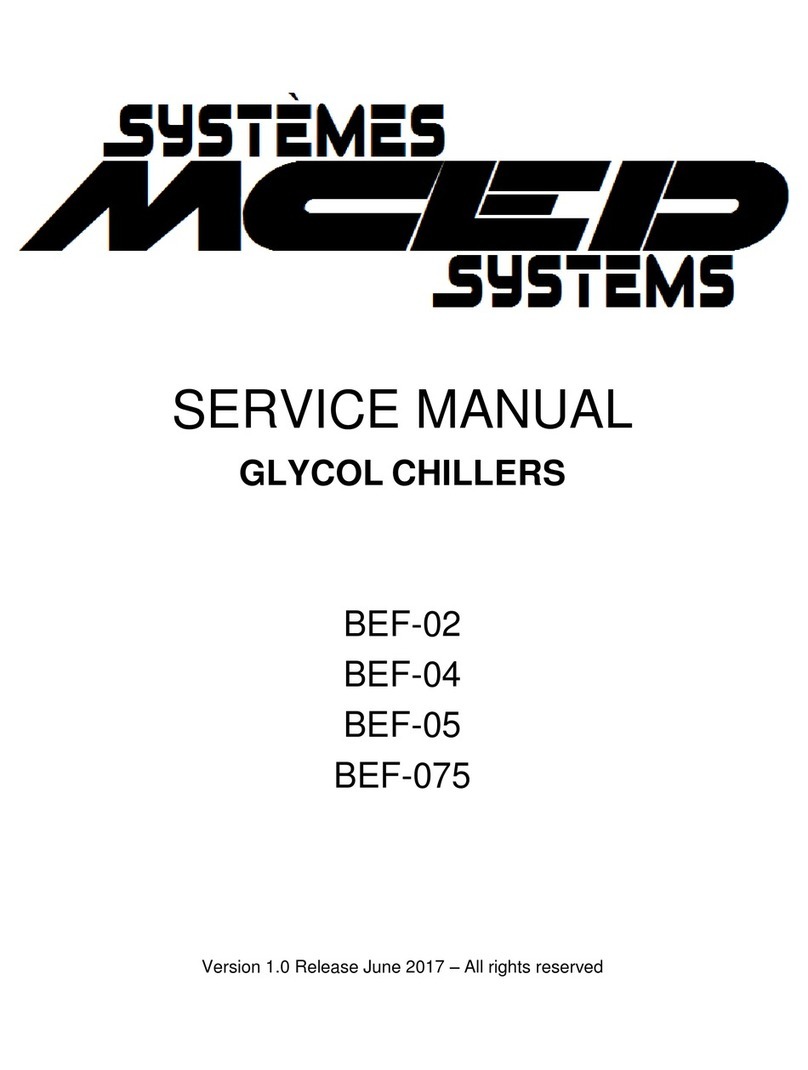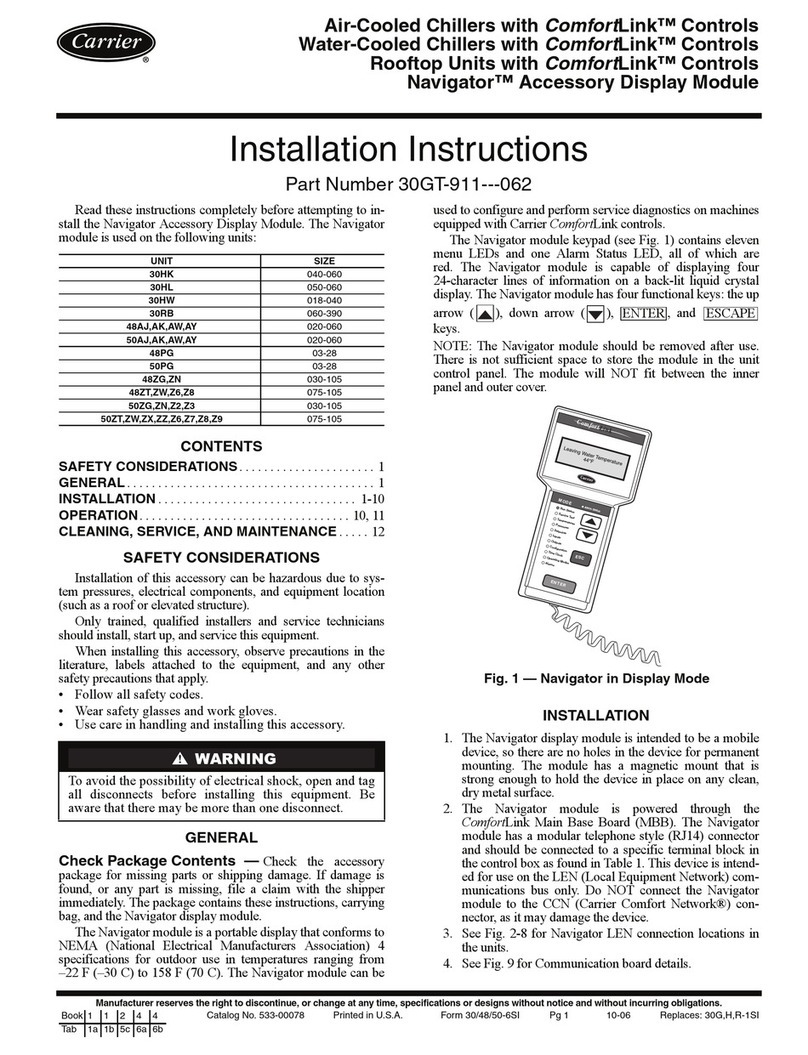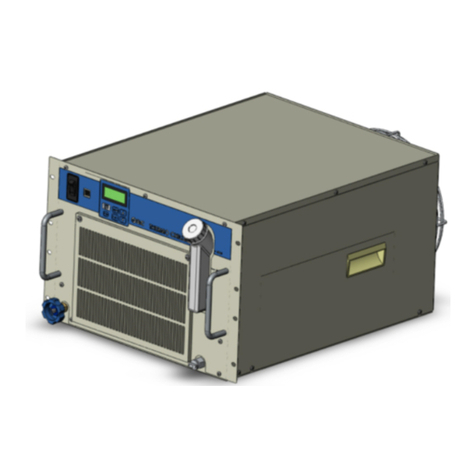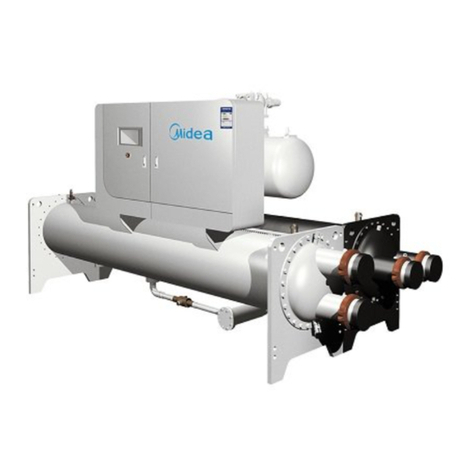Climer ECOHEAT PRO RF EH160 User manual

INSTALLATION AND USER MANUAL
ECOHEAT PRO RF
EH160
EH200
EH260
EH160
EH160
EH200
EH260

Installation and user manual
EH PRO RF 160 - 200 –260
2
Equipment’s serial number
(Filling by technical staff is recommended)

Installation and user manual
EH PRO RF 160 - 200 –260
3
Contents
Introduction..................................................................................................................................................................................... 5
General indications ....................................................................................................................................................................... 5
Safety notes................................................................................................................................................................................ 5
Safety indications for refrigerant R290 ........................................................................................................................ 6
Installers’ qualifications........................................................................................................................................................... 8
Package contents ..................................................................................................................................................................... 8
Instructions for transportation and unpacking .............................................................................................................. 9
Technical information ................................................................................................................................................................10
Operating principle................................................................................................................................................................10
Parts of the ECOHEAT PRO RF unit .................................................................................................................................11
Dimension drawings..............................................................................................................................................................12
Technical data..........................................................................................................................................................................13
Nameplate ................................................................................................................................................................................14
Installation steps ..........................................................................................................................................................................15
Placing ECOHEAT PRO RF...................................................................................................................................................16
Hydraulic connection ............................................................................................................................................................17
Condensate drain..............................................................................................................................................................19
Air connection .........................................................................................................................................................................19
Suction filter ........................................................................................................................................................................21
Electrical connection .............................................................................................................................................................21
Comissioning. Controller .....................................................................................................................................................23
User interface description ..............................................................................................................................................23
Use..........................................................................................................................................................................................25
Operating modes ..............................................................................................................................................................29
Manual reset .......................................................................................................................................................................35
Alarms y solutions.............................................................................................................................................................35
Common failures and possible solutions ............................................................................................................................36
Maintenance..................................................................................................................................................................................37
End of the equipment’s life cycle......................................................................................................................................38
List of spare parts ........................................................................................................................................................................39
Warranty.........................................................................................................................................................................................40
After-sales service sheet...........................................................................................................................................................42

Installation and user manual
EH PRO RF 160 - 200 –260
4

Installation and user manual
EH PRO RF 160 - 200 –260
5
Introduction
You have just acquired a product manufactured by CLIMER TECHNOLOGY. At CLIMER, we
appreciate the trust placed in our company. This product has been manufactured following the
quality standards set by the European Union, incorporating top-quality materials, and its proper
functioning has been tested before leaving our facilities.
Through this installation and start-up manual, you will be guided for the correct setup
of this product. It is essential to carefully read this manual before any handling to avoid
issues arising from improper use of the product.
The company CLIMER TECHNOLOGY reserves the right to modify the information included in
this document at any time without prior notice.
General indications
The following instructions must be followed to avoid any accidents or equipment
malfunctions. Please refer to them again if in doubt or contact technical support.
Do not alter any permanent instructions, labels, or warning plates attached to the
equipment.
Safety notes
The incorrect or inappropriate use of this product could lead to hazardous situations, causing
damage or injuries to the user, third parties or even to the product itself or material goods.
Follow these instructions to avoid any risks.
The installation of the minimum safety devices indicated in this manual (electrical and
hydraulic) is necessary for proper equipment operation. The absence of any device
may cause burns or other injuries in the event of a failure.
As a safety measure, earthing verification is also necessary. The earthing
must comply with the applicable installation standards. Failure to implement
this measure may result in accidents or death.
It is the responsibility of the installer to inform the user about the function and
location of the safety devices installed on the equipment.
The water temperature at the equipment outlet may reach up to 70°C (depending on
the model). Do not touch the pipes during operation to avoid the risk of burns.
The equipment must not be operated by minors or individuals with reduced physical,
sensory, or mental capabilities, or lack of experience and knowledge, without
supervision, unless they have been instructed on the safe use of the device and
understand the associated risks.
Only perform the operations referred to in these operating instructions.

Installation and user manual
EH PRO RF 160 - 200 –260
6
Safety indications for refrigerant R290
The refrigerant R290 in the heat pump circuit does not cause a risk to the
environment; however, the product evaporates quickly and should not be
discharged into the atmosphere or water network. Care should be taken with
its use, mainly for its high flammability.
Do not bring flames or flammable sources near or inside the equipment.
Smoking is forbidden in the proximity and inside the installation compartment.
Do not expose the equipment to environments that can reach extremely high
temperatures to avoid the risk of explosion due to increased internal pressure.
Do not store chemicals or flammable materials near the equipment.
Do not handle sprays near the equipment due to the risk of flammability.
Avoid the accumulation of electrostatic charge in the equipment enclosure.
Do not damage the pipes of the refrigeration circuit.
Do not consume polluted water with refrigerant.
There is a risk of freezing upon contact with the refrigerant.
Avoid all skin and eye contact with the refrigerant at all costs. Otherwise, seek
medical attention.
The following health consequences due to improper use of the refrigerant might
be caused:
▪Burns and cryogenic injury
▪Suffocation
▪unconsciousness
▪Oxygen deprivation
▪Death
The materials and components of this equipment comply with the relevant regulations
against fire and explosion risks, regarding the temperature that can reach the surfaces of
the equipment in contact with the refrigerant in case of leakage.
In the case of detecting a leak, you should be aware of its danger and consider
the following indications:
The coolant should not smell bad. It is completely odourless.
Do not inhale vapours or gases emanating from refrigerant circuit leaks.
The refrigerant vapours are heavier than air; therefore, there may be a decrease
in the oxygen content in the enclosed space, leading to asphyxiation.
Avoid the risk of injury from contact with refrigerant.
Do not operate electrical switches, sockets, doorbells, telephones or intercoms.

Installation and user manual
EH PRO RF 160 - 200 –260
7
You must disconnect the equipment from the power source and ventilate the
area, preferably mechanically, before handling the equipment. If possible, fully
open doors and windows to ensure proper airflow.
While ventilating the area, you must ensure that the refrigerant does not enter
neighbouring buildings through ventilation holes, doors, windows, trapdoors, or
similar openings.
Do not bring any open flames near the area where the leak occurred, do not
operate electrical appliances, and refrain from smoking.
Leave the contaminated enclosure and prevent third parties from entering.
Contact after-sales service.
The appliance is supplied with 150 g of R290 refrigerant gas inside the equipment. The
device is not provided with any charging or recharging valve because this operation must
not be conducted in any case by the user. Refill can only be made at the manufacturer’s
establishment or by specially qualified professionals authorised by the manufacturer.
In case of an accident, here are some first-aid steps you can take:
Symptom
Step
Inhalation
Remove the affected person from the enclosure. Consult a doctor.
Contact with skin
- Rinse thoroughly with lukewarm water.
- Do not remove clothes, which can stick to the skin.
- If burns appear on the skin, seek medical attention immediately.
Contact with
eyes
Rinse with plenty of water with the eyelids open for at least 15
minutes. Consult an ophthalmologist immediately.
In the event of a fire, the appropriate extinguishing means are:
Water atomiser
Dry powder (for example: fire extinguisher)
Carbon dioxide, CO2 (for example: fire extinguisher)
Never attempt to extinguish the flames with a strong water jet. Cool exposed containers
spraying water on them. Firefighting staff must wear self-contained breathing devices
and full-body protection to act.

Installation and user manual
EH PRO RF 160 - 200 –260
8
Installers’ qualifications
Maintenance should only be performed by specially qualified and authorized personnel with
a valid refrigeration technician certification. All maintenance staff and other individuals
working near the appliance must be instructed about the nature of the work to be carried
out.
The installer must inform the user about the product's applications, its use,
handling, and provide all the documentation supplied with the equipment.
The personnel in charge of the equipment installation must have the necessary
tools, including a refrigerant leak detector in the environment, with a sensitivity
equal to or greater than 10-6 Pa·m3/s, and a fire extinguisher.
Package contents
The ECOHEAT system comprises the following components:
ECOHEAT PRO RF unit
Safety valve (6 bar)
Silent-blocks
Drainage nozzle
Blockage for the condensate drain on the heat pump tray
User manual
Security Kit G3 (Optional)
•T&P valve, ½”
•Inlet group reduction of 3 bar and safety of 8 bar
•Tundish Ø15mm x Ø22mm

Installation and user manual
EH PRO RF 160 - 200 –260
9
Instructions for transportation and unpacking
The unit is supplied packed into a wooden pallet properly secured to prevent damage during
transport.
The material used to the packing are recyclables, so dispose it in an appropriate container.
Be careful when using knives or cutters to open the cardboard box so as not to damage the
equipment.
Use a forklift or hand pallet truck to transport the unit to the installation site, always
introducing the forks into the bottom of the pallet being careful not to damage or knock over
the unit.
Illustration 1: Methods of transport of equipment
In case of manual transport, it is forbidden to carry equipment with an inclination greater
than 15º to the vertical for long period of time. Otherwise, the equipment should be in this
position only for the necessary time. After transportation in this way, the equipment needs to
remain still in a vertical position for at least 6 hours to ensure the proper return of oil within
the equipment. All manual operations must always be carried out by minimum 2 people to
prevent accidents.
In case you identify any damage at the time of the reception of the unit, it is mandatory to
register it in the reception note of the transport company, and then, submit the complaint.
For this reason, it is recommended to make a thorough visual inspection of the goods before
signing the reception note.

Installation and user manual
EH PRO RF 160 - 200 –260
10
Technical information
All relevant technical information about the equipment is provided in this manual.
However, according to regulations, CLIMER TECHNOLOGY is available to provide
additional information about the equipment if required.
The ECOHEAT PRO RF equipment has been designed and manufactured in compliance with all
applicable current regulations.
Operating principle
Illustration 2: Operating principle

Installation and user manual
EH PRO RF 160 - 200 –260
11
Parts of the ECOHEAT PRO RF unit
Illustration 3: Detailed view of the unit
1.
Front cover
2.
EVCO touch control
3.
Plastic top cover
4.
Air filter
5.
Back cover
6.
Side covers
7.
Silent-Blocks
8.
Electric heater 1500 W
9.
DHW probe NTC1
10.
PVC protective cover
11.
T&P valve
12.
Low pressure switch
13.
High pressure switch
14.
Compressor
15.
Evaporator
16.
Solenoid valve
17.
Expansion valve
18.
Air box part 1
19.
Air box part 2
20.
Fan
21.
Air temperature probe NTC2
22.
Drain fitting (plugged)
23.
Filter drier
24.
Heat pump tray
25.
Drain fitting
26.
Fan capacitor
27.
Compressor capacitor
28.
Safety thermostat
29.
Terminal strip

Installation and user manual
EH PRO RF 160 - 200 –260
12
Dimension drawings
Illustration 4: Side and up views. Dimensions (mm)
A
B
C
D
E
F
G
EH160 PRO RF
584
624
1311
216
350
80
80
EH200 PRO RF
584
624
1540
216
355
305
80
EH260 PRO RF
584
624
1907
216
355
672
80
Illustration 5: Back (left), front (center) and top connections
H
Condensate drain, 20 mm
M
Hot water outlet, ¾“ F
I
Power supply, 230 V / 1 PH / 50 Hz
N
Electrical heater, 1500 W /
Temperature sensor
J
Exhaust air connection, 150/160/200
mm
O
Cold water inlet, ¾“ F
K
Intake air connection, 150/160/200
mm
P
Drainage outlet, ¾“ F
L
T&P valve, ½“ F

Installation and user manual
EH PRO RF 160 - 200 –260
13
Technical data
Model
EH160
PRO RF
EH200
PRO RF
EH260
PRO RF
Cylinder
Capacity (l)
160
200
260
Maximum operating pressure (bar)
6
Heat pump data
Load profile
L
L
XL
Heating capacity range (W)
1005 - 1750
Power input range (W)
405-500
Water heating energy efficiency, average
climate (%)
118
123
133
COP (average climate, 7ºC)
2.83
2.95
3.24
COP (warm climate, 14ºC)
3.09
3.16
3.55
Energy efficiency class
A+
A+
A+
Ambient temperature range (ºC)
-10 / 40
DHW temperature range (ºC)
35 / 60
Maximum DHW temperature with HP (ºC)
60
Refrigerant / Charge (g)
R290 / 150
Sound power (dB(A))
58
Sound pressure at 2 m (dB(A))
47
Auxiliary electric heater
Electrical heater power (W)
1500
Maximum absorbed power (W)
2000
Maximum water temperature with electrical
heater (ºC)
70
Air data
Maximum air flow rate (m3/h)*
Low speed
264
High speed
370
Maximum available static
pressure (Pa)
Low speed
30
High speed
100
Connection diameter (mm)
150 / 160 / 200
Connections
Power supply (V/ph/Hz)
230 / 1 / 50
Inlet/outlet water connections (inch)
¾” F
Hydraulic connection safety valve / T&P
(inch)
½” F
*: Air flow rate without conducting

Installation and user manual
EH PRO RF 160 - 200 –260
14
Nameplate
The nameplate contains product details and important information:
Type of product
Date of production
Serial number (also available in this
manual)
Power supply
Operating pressure
Electrical supply
IP class
Type of refrigerant
The nameplate must always be accessible and
remain legible throughout the equipment's
entire lifespan. If it becomes damaged or
illegible, replace it immediately. Never remove or
cover the nameplate or labels affixed to the heat
pump equipment.
Illustration 6: Nameplate’s location

Installation and user manual
EH PRO RF 160 - 200 –260
15
Installation steps
Before starting the installation, the installer must perform safety checks to minimise the risks
entailed working with flammable refrigerants. Also, the availability of all the necessary
components and tolls must be checked:
Drill
Screwdriver
Hydraulic installation components
Electric installation components
Fire extinguishing equipment (dust or CO2)
Once it has been checked that it is available all the necessary components and tools, the
installer should follow the next steps:
1) Placing the ECOHEAT
2) Hydraulic installation
3) Air connections
4) Electric installation
5) Commissioning
Before and during the work, the site should be checked with a refrigerant detector to
monitor the presence of toxic or flammable gases or vapours.
The original design allows easy removal of the casing, the front cover, to make easier access
during installation, inspection and maintenance tasks.
If the electrical supply to the dwelling and the product is interrupted during an extended absence,
request a specialized installer to protect it from frost to prevent fatal damage to the product.

Installation and user manual
EH PRO RF 160 - 200 –260
16
Placing ECOHEAT
The place where the system will be installed should allow an easy access in order to make
maintenance work or inspection; in addition to abide by safety measures of refrigerant R290.
It is recommended to meet the following minimum distances in the enclosure:
Illustration 7: Minimum recommended distances at the equipment’s site (in mm)
The equipment has been designed for indoor installation. The enclosure must be equipped
with the following minimum requirements:
Minimum temperature 5 ºC.
Adequate water and electricity supplies.
Drainpipes to discharge water in case of emptying the tank, using the safety valve or
breaking the hydraulic circuit; in addition, for the condensation water outlet
connection.
For potential major water leaks, a containment system or procedure.
Sufficient illumination.
Volumetric capacity not less than 10 m3. Otherwise, adequate minimum ventilation
must be ensured.
Dry and protected from frost.
The air outlet temperature of the device is approximately 5-10°C below the inlet temperature.
So, in case that the exhaust air would not be ducted, the room temperature will be
considerably reduced.

Installation and user manual
EH PRO RF 160 - 200 –260
17
Besides these factors, it is important to consider the following guidelines regarding the
location:
The surface where the unit will be installed must be capable of supporting its weight.
Moreover, it should be flat or have a maximum inclination of 2º.
Since the equipment may cause vibrations or noise, it is recommended to install it
away from resting areas.
Installer must install the supplied Silent blocks to avoid the transmission of vibration.
Hydraulic connection
For the hydraulic connection, it is essential to be aware of local regulations. Respect the
minimum and maximum water pressure and temperature to ensure the proper functioning
of the appliance.
It is recommended to fill the unit with water that meets the characteristics indicated in the
Warranty section located at the end of this manual. To ensure better performance and
durability, the installation of a water softener treatment system is also recommended.
The hydraulic connections are shown in the following scheme. The installer must place the
indicated components as shown.

Installation and user manual
EH PRO RF 160 - 200 –260
18
Illustration 8: Standard hydraulic connection
1.
Cold water inlet
7.
T&P valve
2.
Ball valves
8.
Expansion vessel
3.
Pressure reducing valve
9.
Y merger
4.
Non-return valve
10.
Tundish
5.
Lined filter strainer (Y-type)
11.
DHW outlet
6.
Drainage
There are other possible connection options; as some examples below:
Connection to thermal solar installation
Connection to support existing DHW equipment (heater, boiler, etc.)
Setting electrolytic hoses in the water connections should be considered to prevent galvanic
corrosion in the pipes.
Once the hydraulic connections are made, vent the circuit to avoid the air inside the
installation.

Installation and user manual
EH PRO RF 160 - 200 –260
19
Condensate drain
The condensation in the evaporator could produce a constant water flow that has to be
drained properly; also, to avoid unwanted odours of equipment in ambient air.
The condensate drain is in the back or in the front of the system. (Illustration 5, H).
Connect the condensate drain to the wastewater network making a siphon through a
flexible tube with inner diameter 20 mm. Ensure that water can flow freely.
Air connection
The ECOHEAT unit has two air connections located on the top cover of the equipment. There
are different connection possibilities, as shown below, which can be installed in compliance
with the current regulations. However, the cold air outlet must always be ducted to the
outside of the enclosure, except when it is in technical room.
Illustration 9: Air duct positions and locations
There is the possibility of ducting the cold air to a specific area for cooling. Through a damper,
it can be redirected outside when cooling that area is not necessary.
The ECOHEAT design provides the option to choose between 3 different pipe diameters for
air ducting. The selection of the pipe size to be used is at the discretion of the
installer/technician responsible for the design and calculation of the installation.

Installation and user manual
EH PRO RF 160 - 200 –260
20
Illustration 10: Options for connecting air conduction to equipment and its measurements
When ducting air connection, the tube which will be used for must be rigid PVC or a material
with similar stability.
For the accessories, the following table is provided with the equivalent distance of pressure
drop. The values are calculated for the total length of suction and air discharge ducts. Special
attention should be given when installing the following elements and their pressure drop:
Corrugated pipe for air conduction
Anti-insect grids on the end of air inlet and outlet tubes
Accesories
Equivalent distance of pressure drop (m)
150
160
200
Maximum available
length
V1
11
15
30
V2
16
30
50
Elbow 90º
V1
1.5
2.0
2.5
V2
1.5
2.5
3
Vertical tube (1 m)
V1
1
1
1
V2
1
1
1
Flexible/corrugated
pipe
V1
5
5
5
V2
5
5
5
Anti-insect grid
(at air inlet and outlet)
V1
5
5
5
V2
5
5
5
V1: fan’s low speed V2: fan’s high speed
To prevent condensation, it is recommended to insulate the air evacuation pipes and air duct
connections with a vapor-tight thermal coating.
This manual suits for next models
2
Table of contents
Other Climer Chiller manuals
Popular Chiller manuals by other brands
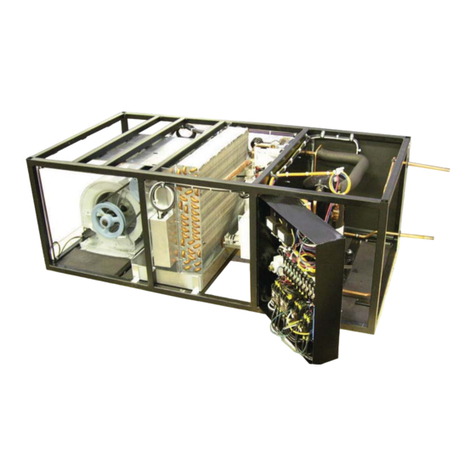
Data Aire
Data Aire MINI CEILING SERIES Installation, operation and maintenance manual
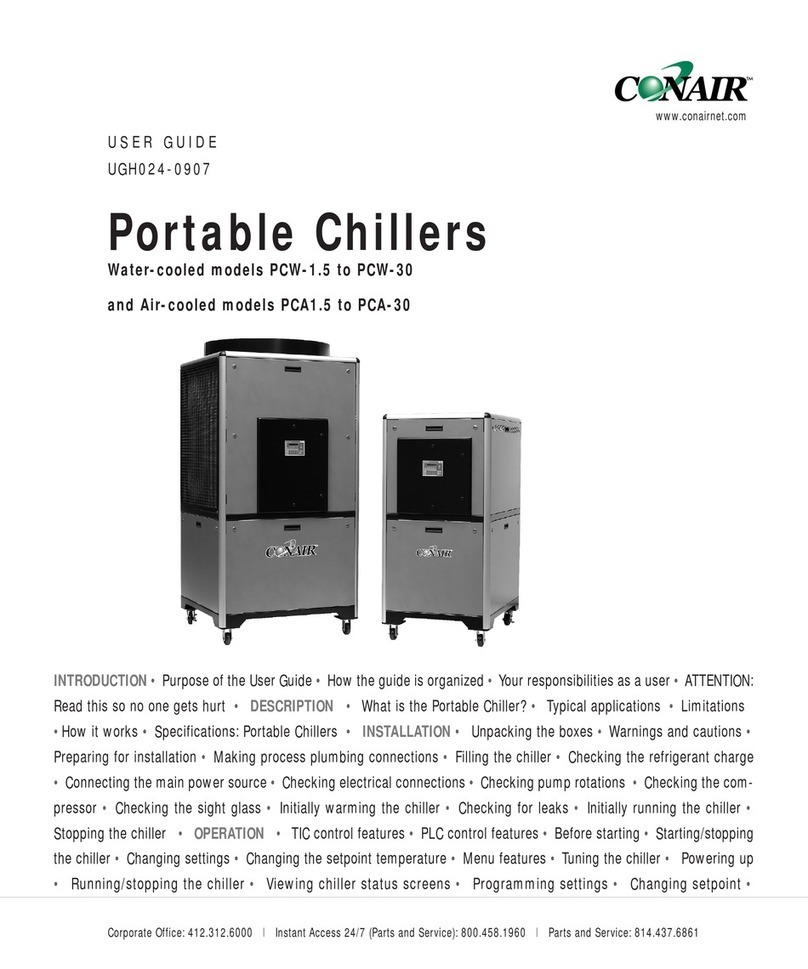
Conair
Conair PCW-1.5 user guide
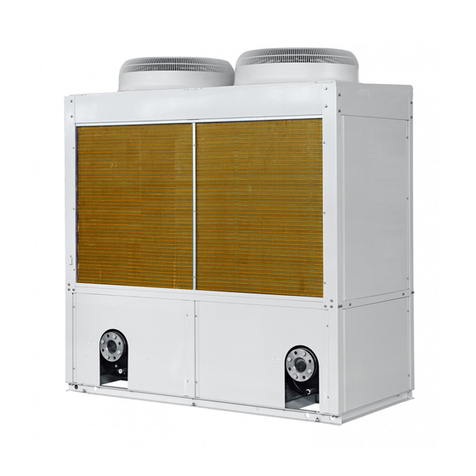
Gree
Gree B Series Service manual
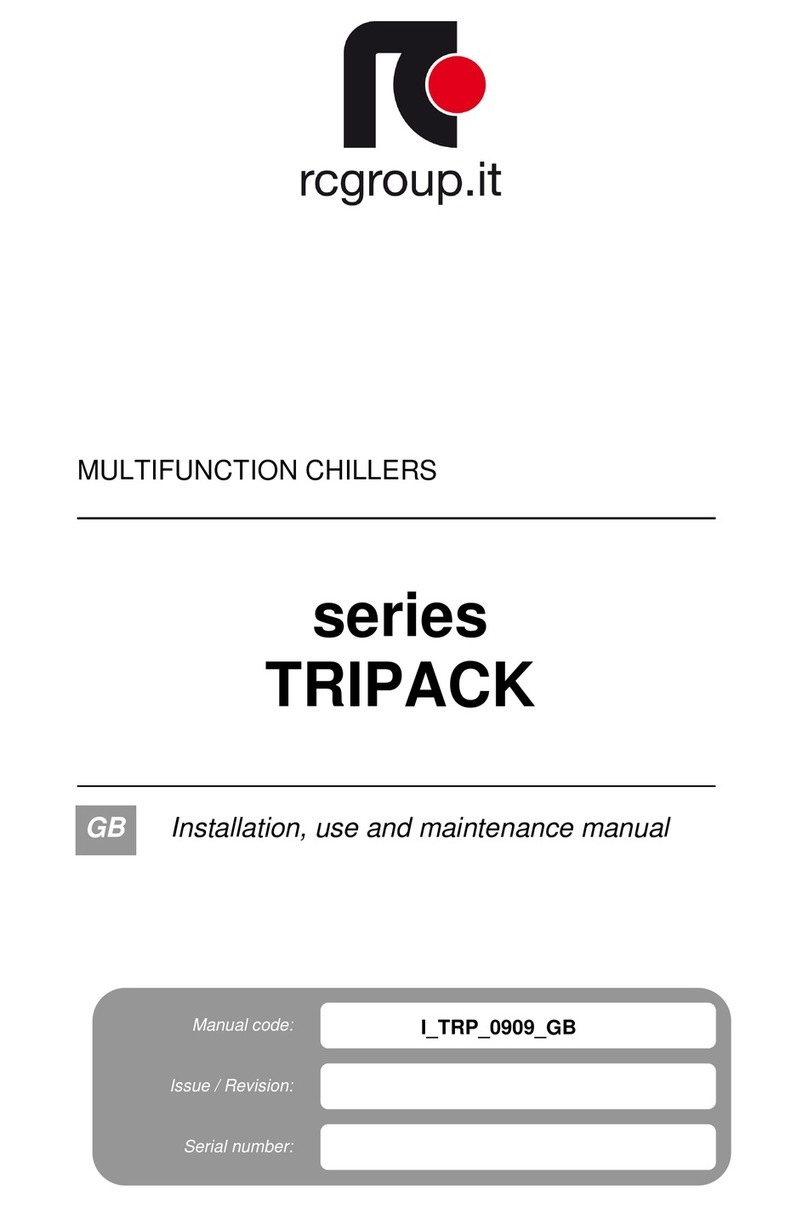
RC GROUP
RC GROUP TRIPACK Series Installation, use and maintenance manual
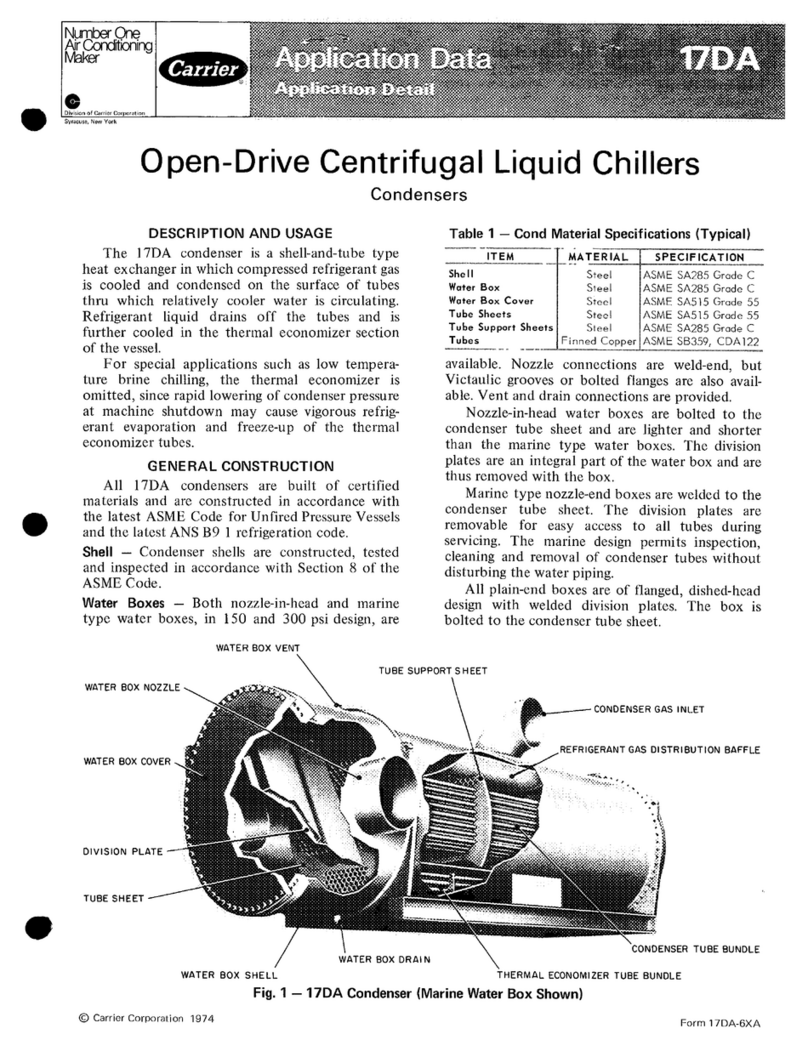
Carrier
Carrier 17DA Application data
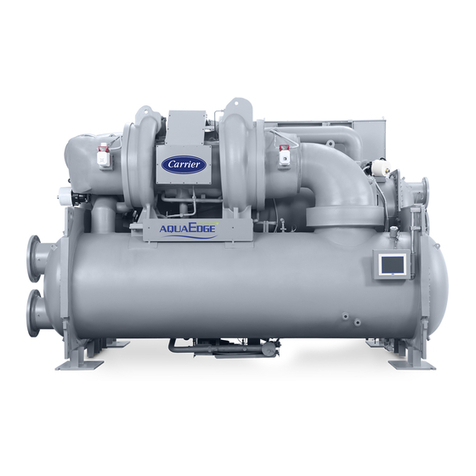
Carrier
Carrier AquaEdge 19DV series installation instructions

York
York YCWL0056SE Installation operation & maintenance
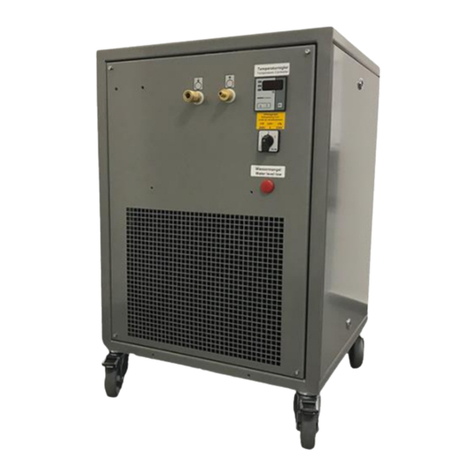
Comet
Comet XRCA-3023-WA manual
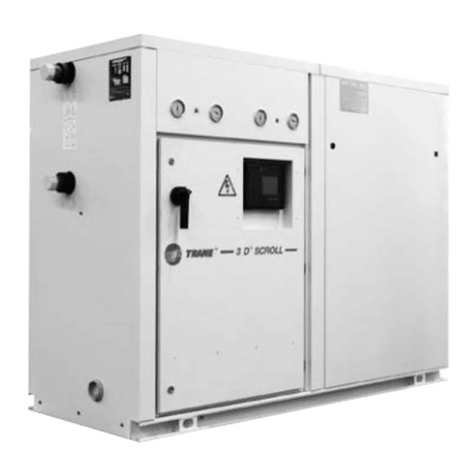
Trane
Trane CGWH 115 Installation operation & maintenance
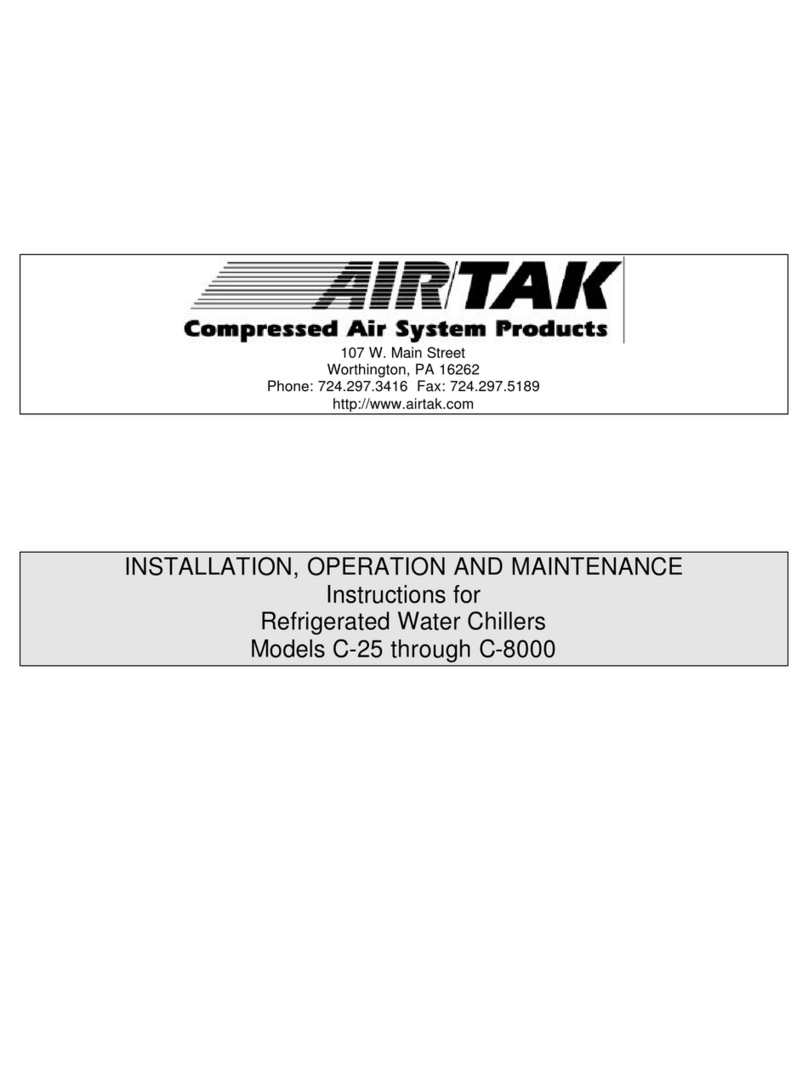
AIRTAK
AIRTAK C-25 through C-8000 Installation, operation and maintenance instructions
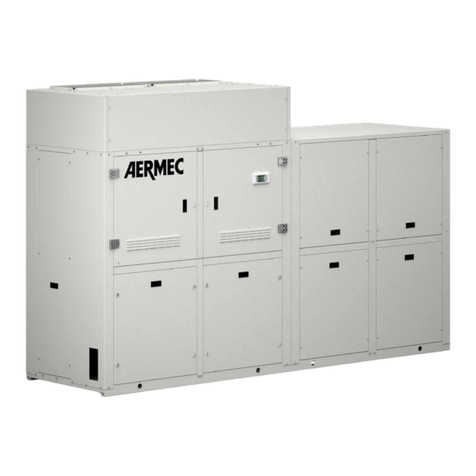
AERMEC
AERMEC NLC 0280 installation manual
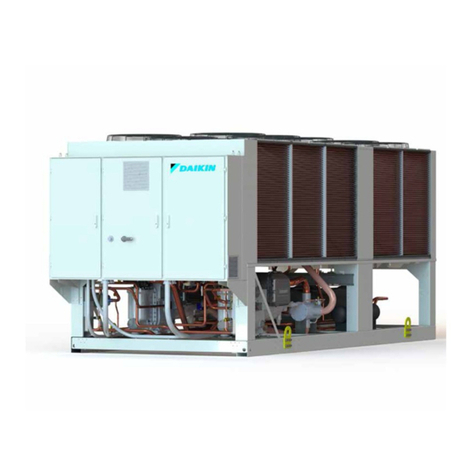
Daikin
Daikin EWYD-4Z B Installation, operation and maintenance manual


